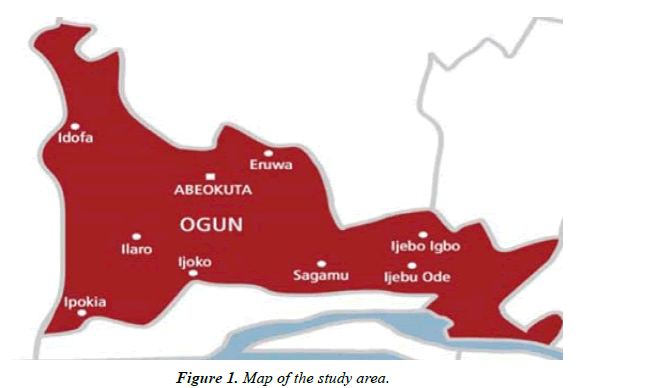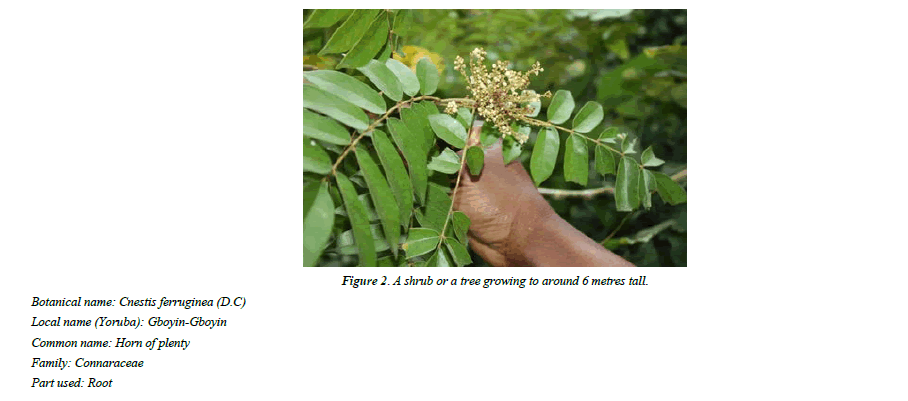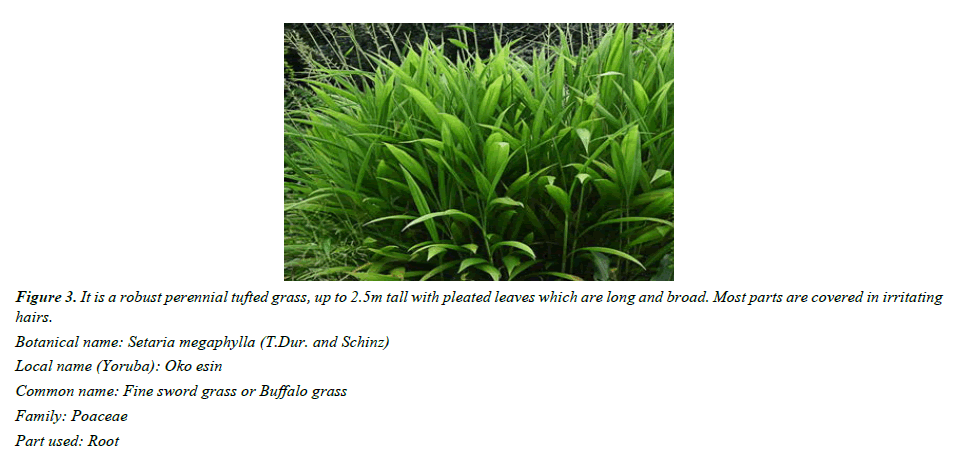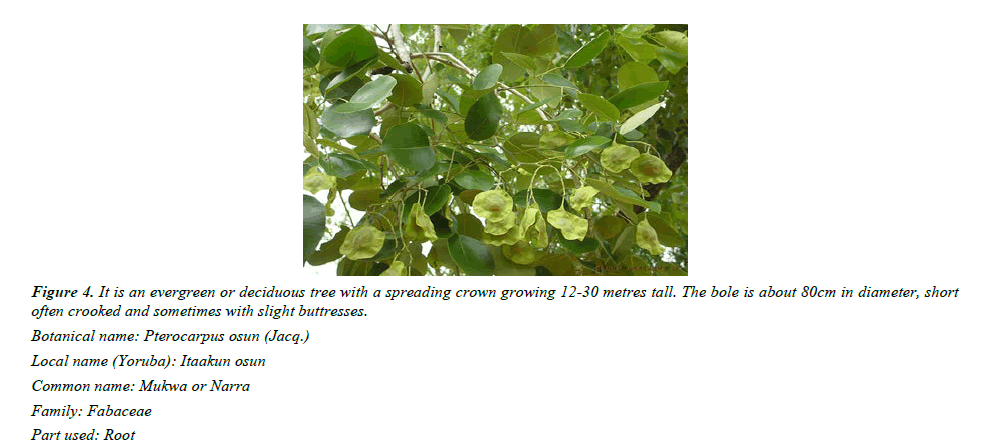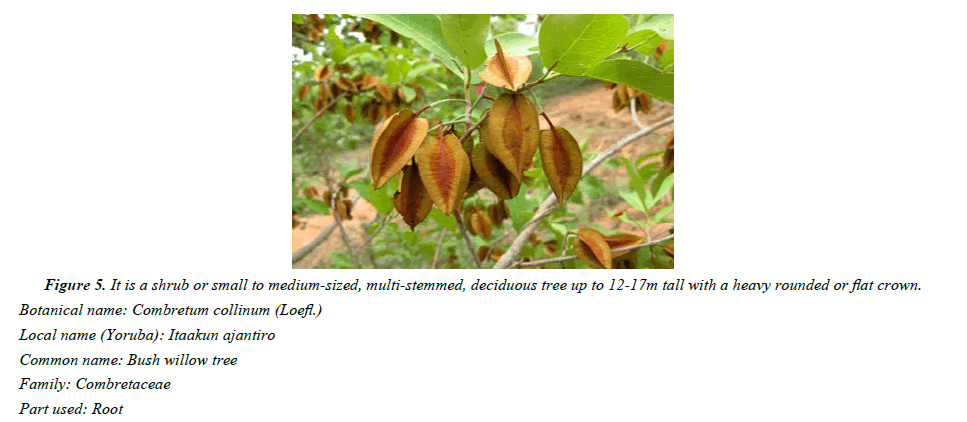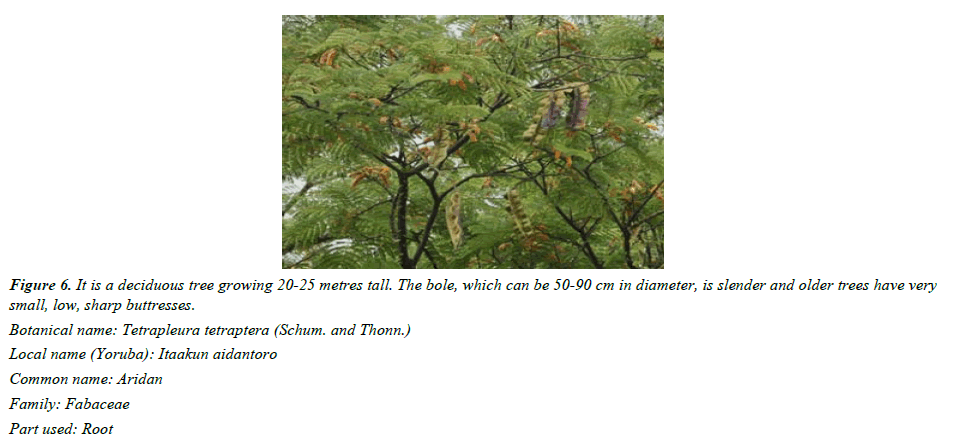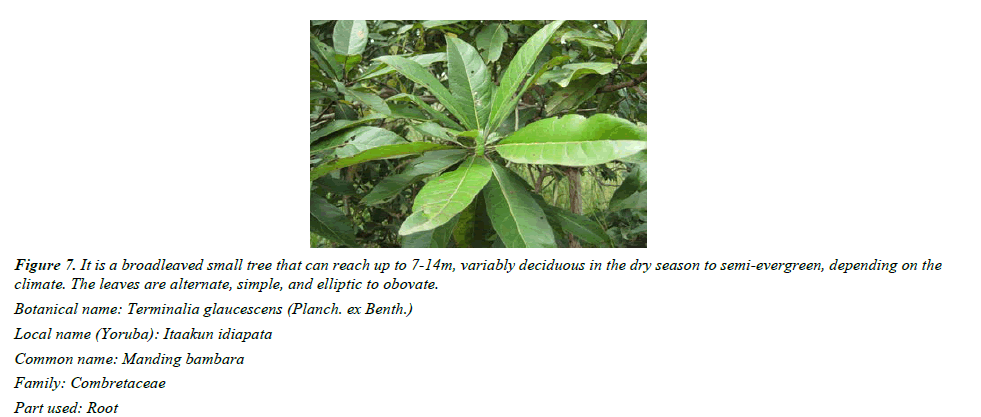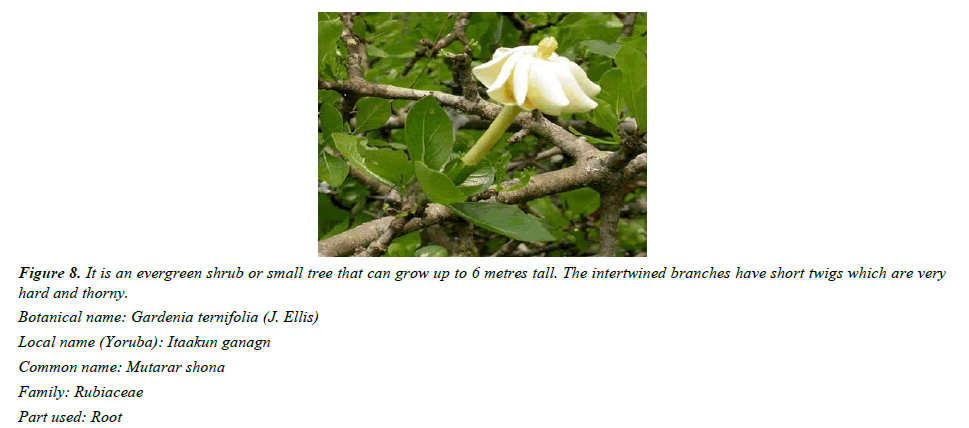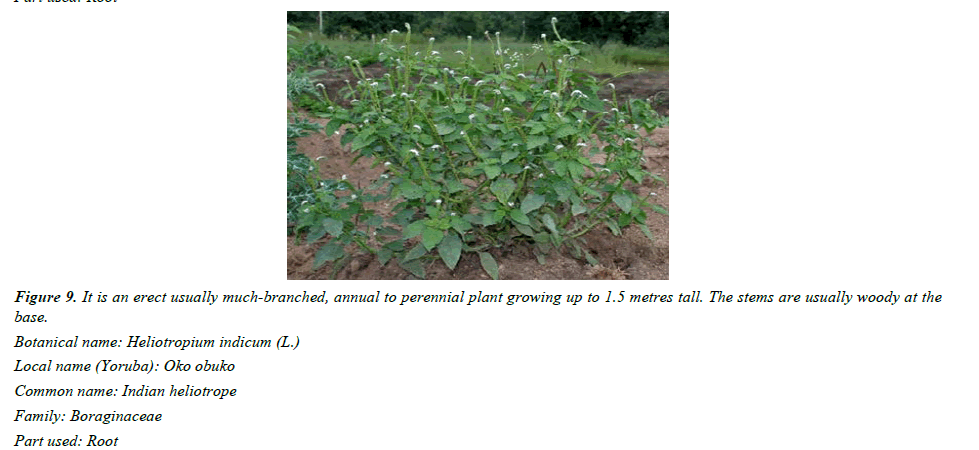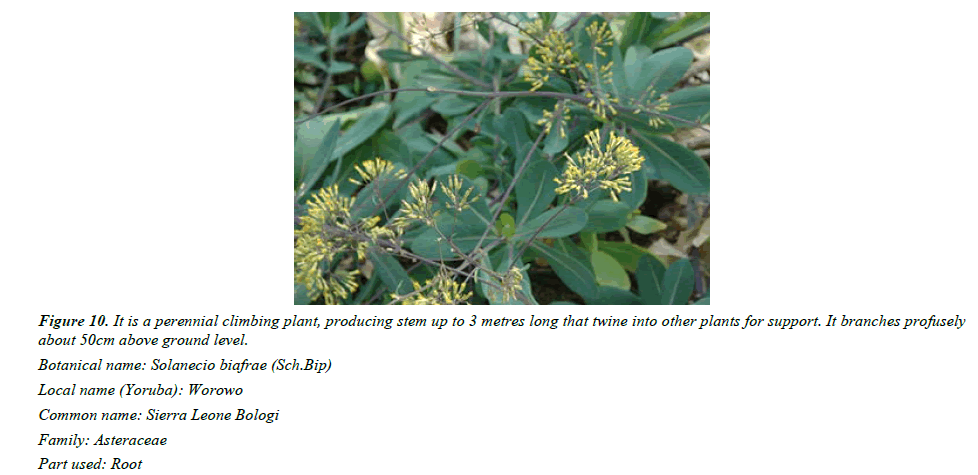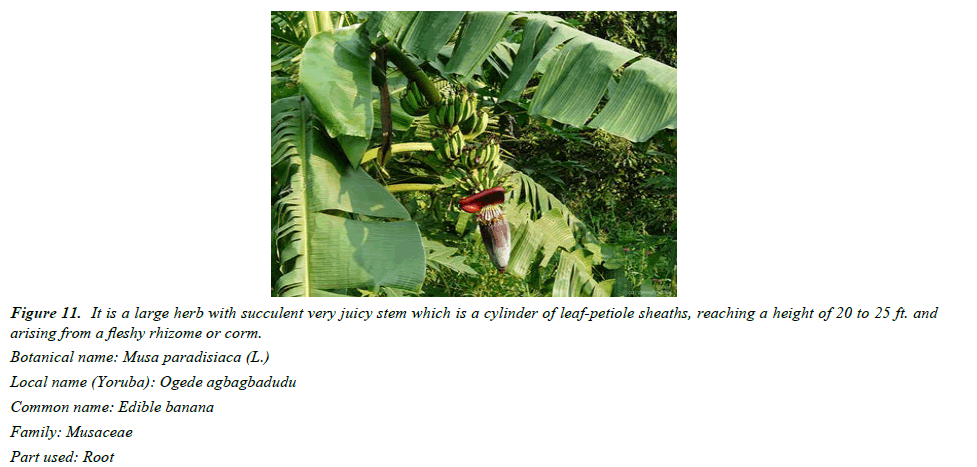Review Article - Journal of Pharmaceutical Chemistry & Chemical Science (2022) Volume 6, Issue 3
Ethnobotanical survey and phytochemical screening of some plants used in the management of sexual dysfunction.
Great Iruoghene Edo1*, Laurine Chikodiri Nwosu2, Favour Ogheneoruese Onoharigho3, Evidence Akhayere4
1Department of Chemistry, Cyprus International University, Nicosia, Cyprus
2Department of Health Care Organizations Management, Cyprus International University, Nicosia, Turkey
3Department of Chemistry, Elizade University, Ondo, Nigeria
4Department of Chemistry, Environmental Research Centre, Cyprus International University, Nicosia, Cyprus
- Corresponding Author:
- Great Iruoghene Edo
Department of Chemistry
Cyprus International University
Nicosia, Cyprus
E-mail: greatiruo@gmail.com
Received: 18-Mar-2022, Manuscript No. AAPCCS-22-57687; Editor assigned: 21-Mar-2022, PreQC No. AAPCCS-22- 57687(PQ); Reviewed: 04-Apr-2022, QC No. AAPCCS-22-57687; Revised: 26-May-2022, Manuscript No. AAPCCS-22- 57687(R); Published: 02-Jun-2022, DOI: 10.35841/aapccs-6.3.112
Citation: Edo GI. Nwosu L, Onoharigho FO, et al. Ethnobotanical survey and phytochemical screening of some plants used in the management of sexual dysfunction. J Pharm Chem Chem Sci. 2022;6(3):112
Keywords
Sexual enhancement, Phytochemical analysis, Ethnobotanical information, Questionnaire.
Background
Sexual dysfunction is a commonly faced sexual disorder that has a significant impact on the quality of one's life and can jeopardize the stability of a one's relationship. This could be an issue with desire for a partner, arousal, the act of sex, or achieving orgasm during intimacy. While both men and women have a variety of challenges when it comes to sexual intercourse, these issues usually fall into one of the following categories: Challenges with orgasm, sexual desire disorders, pain during intercourse and Arousal disorders [1].
The general population has a high rate of sexual dysfunction. It's estimated that 43% of women and 31% of men suffer from one or other kind of sexual dysfunction. Among men, premature ejaculation is the most prevalent kind of male sexual dysfunction. There is no consensus on the most common sexual dysfunction in women with some studies claiming hypoactive sexual desire disorder to be the most popular, followed by orgasmic and arousal disorders; while other studies report difficulty achieving orgasm and vaginal dryness to be the most common types of sexual dysfunction in women. Sexual dysfunction can be inherited or acquired, and it can be general or situational [2].
Congenital, immunological, iatrogenic, and endocrine causes are the most common factors that reduce the chances of conception in females. In many situations, inability to conceive is caused by oligozoospermia, sexual, and ejaculatory dysfunction [3]. Despite the fact that numerous synthetic medications are accessible and/or utilized to treat these issues, some of the disadvantages of these drugs include their high cost and potential for major side effects, effective natural alternatives are therefore still in demand [2]. Even though many plants and natural products claim to be useful without scientific evidence, a number of them are active and have biological activity that has been verified by scientific research.
Medicinal plants have been reported to be useful for treatment of several diseases [4]. This is because plants may produce a large range of secondary metabolites, which can be used to treat a number of ailments. Plant compounds regulate their effects in human body via mechanisms that are similar to those found in conventional drugs, therefore herbal medicines are not so different from conventional drugs as regards mechanism of actions [5]. Despite advances in modern medical and pharmaceutical research, the use of herbal medicine has become an important part of everyday life [6].
Traditional medicine has also proven to be effective in the management of various diseases and about 60% of rural population depends on it for their primary health care. Traditional health care givers rely on their familiarity, experience and practice with the various plants based on the ideas and beliefs passed on for generations for preservation of well-being. Herbalists, healers, spiritualists, hunters and farmers in Nigeria use many different species of plants as a usual source of medicine. WHO had earlier estimated that the usage of traditional medicine for primary healthcare in developing countries was 80% and most of which involved the use of plant extracts. This is an indication that herbal medicine is important in primary health care provision in developing countries like India. The aim of this research is to gather ethnobotanical information of the plants used for enhancing sexual mood and to evaluate the phytochemical and nutritional content of different parts of the most mentioned plants recorded.
The skepticism regarding the concept of aphrodisiac is not unwarranted, although a thorough evaluation and collection of scientific information may provide a basis for the evidencebased utilization of plants or plant based products for the treatment of sexual dysfunction in general [7]. This study is an attempt to gather ethnobotanical information of the plants used for managing sexual dysfunction by enhancing sexual desire and to evaluate the phytochemical and proximate content of different parts of the most recorded plants.
Methods
Study area
The study was conducted in Abeokuta, Ogun State, Nigeria. The city lies in the Southwest tropical rainforest zone. The annual temperature ranges between 22. 800 C to 34.900 C. The people of Abeokuta have three festivals which are Egungun, Igunuko and Oro, it has its headquarters at Ake. There are many cottage industries in Abeokuta some of these are pottery tie and dye, wood carving, blacksmithing etc. Figure 1.
Study site
Trips were taken to different local markets in Abeokuta such as Kuto, Ijaye, Itoku and Lafenwa market.
Informed consent
The purpose of the study was conveyed to the local traditional practitioners, herb sellers and community leaders in the study area. Following that, all participants gave their informed consent before the researcher proceeded with the survey.
Data collection
Fifty (50) questionnaires were distributed to traditional herbal practitioners and herb sellers, to collect information on commonly used herbs for sexual enhancement as well as information relating to their administration and duration of use.
Determination of phytochemicals in plant samples
Steroids: In a 100 ml beaker, 20 ml C2H5Cl3O was added to 0.5 g of sample extract. The extract was dissolved by shaking for 30 minutes. After passing through a Whatman No. 1 filter paper, the entire blend was filtered into a dry clean conical flask. The resultant residue was treated with a chloroformmethanol combination indefinitely until it was steroid-free. In a 30 ml test tube, 1 ml of the filtrate was added to 5 ml of alcoholic KOH and vigorously stirred until uniform. After that, the mixture was steam bathed for 90 minutes at 37° C-40 °C. It was allowed to cool to room temperature before adding 10 ml C6H14 and 5 ml distilled water. This was evaporated to dryness in the water bath. 6 ml Liebermann Burchard reagent was added to the dry container containing the residue, and absorbance was measured on a Spectronic 21 D digital Spectrometer at 620 nm [8].
Alkaloids: A weighing scale was used to weigh 5 g of each sample, which was then dissolved in 50 ml of a 10% CH3COOH in C2H5OH. Before filtering, the solution was mixed and allowed to sit for about 4 hours. On a heated plate, the filtrate was reduced to a fraction of its original volume. Concentrated NH₄OH was added in a drop wise motion to precipitate the alkaloids. A pre-weighed filter paper was used to remove the precipitate, which was subsequently washed with 1% NH4OH solution. The filter paper with the precipitate was dried in an oven at 600°C for 30 minutes, and then weighed again until a consistent weight was reached [9].
Saponin: 2 g of sample was weighed into a 250 ml beaker, 100 ml of isobutyl alcohol was added, and the mixture was shaken for 5 hours to achieve a homogenous solution. The mixture was then filtered through a No. 1 Whatman filtered paper. The filtrate was then transferred to a 100 ml beaker and saturated with magnesium carbonate solution. The resulting mixture was then filtered to produce a clear colorless solution that could be measured at 380 nm using a spectrophotometer. 0 ppm to 10 ppm of standard saponin solutions were prepared from 1000 ppm saponin stock standard solution and saturated with magnesium carbonic as above and also filtered. The absorbance of the saponin standard solution was also read at 380 nm to obtain the gradient of plotted curve [10].
Flavonoids
1 g of the sample was measured into 250 ml conical flask. 250 ml of warm distilled H2O was added and placed in a water bath for 10 minutes at 100°C before filtration. 1 ml of the filtrate was pipetted into a test tube and 1 ml of 0.5 N sodium hydroxide was added. About 6 ml of distilled H2O was added and left to stand for 10 minutes. Absorbance was prepared using 0.5 ppm, 1 ppm, 1.5 ppm, and 2.5 ppm [11].
Determination of anti -nutrients in plant samples
Cyanogenic glycoside: In a distillation flask with an 800 cm3 capacity, 200 cm3 of distilled H2O was added to 1 g of each sample powder in triplicate. The flask was set up for distillation and left to sit for 120 minutes to allow for autolysis. Antifoaming agent (silicon oil) was applied. Steam distillation was performed and 150 cm3 of the distillate was collected into 250 cm3 capacity conical flask containing 20 cm3 of 2.5 percent NaOH, which was then diluted to mark with distilled H2O. 8.0 cm3 of 6N NH4OH solution and 2.0 cm3 of 5 percent KI were added. This was titrated against 0.02 N AgN03 solutions using a 10 cm3 microburette. The end-point was noted as a permanent turbidity against a black background [12].
Oxalate: 1 g of each sample was weighed into a 250 ml conical flask and immersed in 100 ml of distilled water for extraction. After allowing them to sit for 3 hours, they were filtered using a double layer filter paper. Standard oxalic acid solutions of 10 ppm, 20 ppm, 30 ppm, 40 ppm, and 50 ppm were made and the absorbance measured at 40 nm on a spectrometer [13].
Phytic acid : 2 g of the sample was measured into a 250 ml beaker, and 100 ml of 2% concentrated HCl was used to soak the sample for 3 hours before filtering it through a double layer of toughened filter paper. To get the desired acidity, 50 ml of the filtrate was transferred to a 250 ml beaker, and 107 ml of distilled water was added. As an indicator, 10 ml of 0.3% NH4SCN solution was added to the beaker containing the sample filtrate solution before titration with a standard FeCl3 solution containing 0.00195 g iron per milliliter. The titration was carried out three times, with the average titre being recorded. For each sample, these steps were repeated.
Tannic acid (Tannin): In a conical flask, 0.5 g of sample powder was measured and 100 cm3 of pure H2O was added. This was heated steadily for 1 hour before being filtered into a volumetric flask with a capacity of 100 cm3. Before cooling, the filter paper was rinsed with pure H2O and the filtrate diluted to the 100 cm3 mark. For the greenish-blue color development, 50 cm3 of aliquot was supplied to each flask. After that, 5 cm3 Folin-Dennis reagent was saturated with 10 cm3 Na2CO3 and then diluted to 100cm3 with pure H2O.
After vigorous mixing, the flasks were placed in a water bath at 25°C for 20 minutes before being tested at 700 nm for optical density. Regarding the calibration curve, distilled H2O served as a blank. A standard curve was created using a tannic acid solution as the starting point. The tannin content was calculated using the concentrations gathered from this curve for each sample [8].
Determination of proximate composition
Crude fiber determination: The moisture and fat free samples (1 g) were used to determine crude fiber using H2SO4 and NaOH (1.15%) extraction. The precipitate was rinsed with 10% HCl and absolute ethanol after both extractions and allowed to dry overnight at 105°C. The residue's weight was taken. In a muffle furnace, the sample was heated at 600°C for 80 minutes, and the weight of the residue was calculated as a percentage of crude fibre [14].
Crude Protein Determination
The determination of crude protein was done using Kjeldahl method. With gentle swirling, the dried samples were digested in 10 ml of concentrated H2SO4 and 2 g of catalyst mixture of K2SO4:CuSO4 (10:1). Distillation was carried out in a distillation system after the digested sample had reached a volume of 100 ml. The digested sample of 8 ml was mixed with 0.5 N NaOH. Furthermore, distillation continued for 10 minutes and the distillate was collected in a separate conical flask containing 15 ml of 3% boric acid solution with 1-2 drops of methyl red and bromocresol green indicator. The distillate was titrated against standard 0.1 N HCl solutions until a pink color was visible as compared to the blank [15].
Crude Fat Determination
The content of crude fat in the samples (5 g) was calculated through continuous extraction in a lipid extractor for 2 hours using 100 ml of petroleum ether as solvent, the weight difference of the solvent in the beaker was estimated as the fat content [16].
Ash Determination
Ash content was measured by heating the dry sample (3 g) for 2 hours in a preheated muffle furnace set at 6000C. The crucible was transferred to a desiccator to cool. The weight of the residue was calculated as ash content and expressed as a percentage [17].
Data analysis
One-way Analysis of Variance (ANOVA) was used in analyzing the data and means were separated by Duncan Multiple Range Test (DMRT) of Statistical Analysis System (SAS) at five percent (5%) Confidence Interval.
Result
Commonly used medicinal plants for sexual enhancement
Photographs of the plants used for sexual enhancement were taken. They include (Figures 2-11).
Figure 3: It is a robust perennial tufted grass, up to 2.5m tall with pleated leaves which are long and broad. Most parts are covered in irritating hairs.
Local name (Yoruba): Oko esin
Common name: Fine sword grass or Buffalo grass
Family: Poaceae
Part used: Root
Figure 4: It is an evergreen or deciduous tree with a spreading crown growing 12-30 metres tall. The bole is about 80cm in diameter, short often crooked and sometimes with slight buttresses.
Local name (Yoruba): Itaakun osun
Common name: Mukwa or Narra
Family: Fabaceae
Part used: Root
Figure 6: It is a deciduous tree growing 20-25 metres tall. The bole, which can be 50-90 cm in diameter, is slender and older trees have very small, low, sharp buttresses.
Local name (Yoruba): Itaakun aidantoro
Common name: Aridan
Family: Fabaceae
Part used: Root
Figure 7: It is a broadleaved small tree that can reach up to 7-14m, variably deciduous in the dry season to semi-evergreen, depending on the climate. The leaves are alternate, simple, and elliptic to obovate.
Local name (Yoruba): Itaakun idiapata
Common name: Manding bambara
Family: Combretaceae
Part used: Root
Figure 8: It is an evergreen shrub or small tree that can grow up to 6 metres tall. The intertwined branches have short twigs which are very hard and thorny.
Local name (Yoruba): Itaakun ganagn
Common name: Mutarar shona
Family: Rubiaceae
Part used: Root
Figure 10:It is a perennial climbing plant, producing stem up to 3 metres long that twine into other plants for support. It branches profusely about 50cm above ground level.
Local name (Yoruba): Worowo
Common name: Sierra Leone Bologi
Family: Asteraceae
Part used: Root
Figure 11:It is a large herb with succulent very juicy stem which is a cylinder of leaf-petiole sheaths, reaching a height of 20 to 25 ft. and arising from a fleshy rhizome or corm.
Local name (Yoruba): Ogede agbagbadudu
Common name: Edible banana
Family: Musaceae
Part used: Root
Socio- economic characteristics of the respondents
Table 1 showed that most of the respondents were females (80%) and 56% were within the age bracket of 41-60 years. It was also revealed that 86% of the respondents were married and the highest form of education of most of the respondents was primary school (78%). The table further revealed that 40% of the respondents were traditionalists, 40% Muslims and 20% were Christians. From the table, all the respondents were Nigerians, 48% were herbs sellers, 12% were herbalists, while the others were traditional medical practitioners (40%). The table also showed that about 46% of the respondents had over ten years of practice while 24% had the least amount of experience.
| Variable | Frequency | % Frequency | Mode |
|---|---|---|---|
| Gender | |||
| Male | 10 | 20 | - |
| Female | 40 | 80 | Female |
| Age | |||
| 21-40 | 3 | 6 | |
| 41-60 | 28 | 56 | 41-60 |
| Greater than 60 | 19 | 38 | - |
| Marital status | |||
| Married | 43 | 86 | Married |
| Divorced | 2 | 4 | - |
| Single | 5 | 10 | - |
| Religion | |||
| Christianity | 10 | 20 | -- |
| Islam | 20 | 40 | - |
| Traditionalist | 20 | 40 | Traditionalist |
| Nationality | |||
| Nigerian | 50 | 100 | Nigerian |
| Non –Nigerian | 0 | 0 | - |
| Practice specification | |||
| Herbalist | 6 | 12 | - |
| Herbs seller | 24 | 48 | Herbs seller |
| TMP | 20 | 40 | - |
| Duration of practice | - | - | - |
| 1-5 years | 12 | 24 | - |
| 6-10 years | 15 | 30 | - |
| More than 10 years | 23 | 46 | Greater than 10 years |
| Educational background | - | - | - |
| Primary school | 39 | 78 | |
| Secondary school | 6 | 12 | |
| None | 5 | 10 | Primary school |
Professional experience
From Table 2, all of the respondents were aware of obesity and had treated obese patients. The table also showed that apart from herbs, the other forms of treatment used were divination/ incantation/oracle (2%), incision (12%) and prayers (26%). The frequency of treatment of some respondents was regular (80%) and others irregular (20%). 30% of the respondents sourced their plants from their gardens, 30% from the forest, and 30% from the market. Most of the respondents revealed that there was no side effect of using the treatment. The Table also revealed that 8% of the respondents accompanied the herbs with verbal instructions while the rest did not.
| Variable | Frequency | %Frequency | Mode |
|---|---|---|---|
| Awareness of obesity | |||
| Yes | 50 | 100 | Yes |
| Other treatment used apart from herbs | |||
| Divination/oracle/incantation | 1 | 2 | - |
| Incision | 6 | 12 | - |
| Prayers | 13 | 26 | - |
| None | 30 | 60 | None |
| Frequency of treatment | |||
| Regular | 40 | 80 | - |
| Irregular | 10 | 20 | - |
| Source of plants parts used | |||
| Forest | 15 | 30 | - |
| Around house/home garden | 15 | 30 | Around home |
| Market | 15 | 30 | - |
| Forest and market | 5 | 10 | - |
| Accompanied side effects | |||
| Dizziness | 9 | 18 | - |
| Nausea | 6 | 12 | - |
| None | 35 | 70 | None |
| Accompanied verbal instruction | |||
| Yes | 4 | 8 | - |
| No | 46 | 92 | No |
Table 2. Professional experience.
Recipe and administration
Table 3 showed that 44% of the respondents used the leaves of plants. Dried plant parts were mostly used (82%) by the respondents. The table also revealed that 90% used clay pot and the traditional extraction method by 54% of the respondents was boiling/decoction. The traditional solvent of choice most of the respondents used was water (82%), some others used alcohol (10%) and others used palm wine (8%). The method of administration used by majority of the respondents were drinking (80%) while some was through steaming (16%) and others through steam and inhalation (4%). The recommended dosage for most of the respondents (48%) was a cup full. Finally, (26%) of the respondents got the knowledge of medicinal plants and their uses from training, (34%) from ancestral knowledge, (8%) by divination and (32%) by ancestral and divination.
| Variables | Frequency | %Frequency | Mode |
|---|---|---|---|
| Plant parts used | |||
| Leaves | 22 | 44 | Leaves |
| Fruits | 3 | 6 | - |
| Whole plant | 4 | 8 | - |
| Leaves and other parts | 21 | 42 | - |
| Accompanied verbal instruction | |||
| Yes | 4 | 8 | - |
| No | 46 | 92 | No |
| Forms of plants used | |||
| Dry plant | 41 | 82 | - |
| Fresh | 9 | 18 | - |
| Herbal preparation material | |||
| Clay pot | 45 | 90 | Clay pot |
| Steel/aluminium pot | 2 | 4 | - |
| None | 3 | 6 | - |
| Traditional extraction methods | |||
| Boiling/decoction | 27 | 54 | - |
| Light heating | 13 | 26 | - |
| Steeping/soaking | 5 | 10 | - |
| Infusion | 5 | 10 | - |
| Traditional solvent choice | |||
| Water | 41 | 82 | Water |
| Alcohol | 5 | 10 | - |
| Palm wine | 4 | 8 | - |
| Method of administration | |||
| Steam | 8 | 16 | - |
| Drinking | 40 | 80 | - |
| Steam/inhalation | 2 | 4 | - |
| Dosage | |||
| One full cup | 24 | 48 | One full cup |
| More than a cup full | 16 | 32 | - |
| Less than 10cm | 10 | 20 | - |
| Dosage administration | |||
| Once | 15 | 30 | - |
| 2-3 times daily | 35 | 70 | 2-3 times daily |
| Source of herbal knowledge | |||
| Ancestral | 17 | 34 | Ancestral |
| Training | 13 | 26 | - |
| Divination | 4 | 8 | - |
| Ancestral and divination | 16 | 32 | - |
Table 3. Recipe and administration.
Common plants used for enhancing sexual mood in abeokuta
Table 4 shows the plants collated for enhancing sexual mood. A total of eleven (11) plants were documented. The table shows their local names, botanical names, families, common names and part used. It was observed that Pterocarpus osun was the most mentioned fifty (50).
| Local Name | Common Name | Botanical Name | Family | Part Used | Frequency | Rank |
|---|---|---|---|---|---|---|
| Gboin gboin | Horn of plenty | Cnestis ferruginea | Connaraceae | root | 42 | 2 |
| Itaku osun | Mukwa | Pterocarpus osun | Fabaceae | root | 50 | 1 |
| Itaku ajantiro | Bush willow | Combretm collinum | Combretaceae | Root | 31 | 1 |
| Aidantoro | Aridan | Tetrapleura tetraptera | Fabaceae | root | 6 | 1 |
| Idi apata | Manding Bambara | Terminalia glauscens | Combretaceae | root | 7 | 1 |
| Gangan | Mutarar shone | Gardenia ternifolia | Rubiaceae | root | 18 | 2 |
| Oko esin | Broad leaved grass | Setaria megaphylla | Poaceae | root | 36 | 2 |
| Oko obuko | Indian heliotrope | Heliotropium indicum | Boraginaceae | root | 14 | 2 |
| Worowo | Sierra Leone Bologi | Solanecio biafrae | Asteraceae | root | 9 | 2 |
| Agbagba | Edible banana | Musa paradisiaca | Musaceae | Root | 29 | 2 |
Table 4. List of plants used for enhancing sexual mood.
Enumeration of plant recipe used for enhancing sexual mood: Table 5 shows herbal recipe used for enhancing sexual mood. The table showed the names of plants, preferred solvent, method of preparation, and mode of administration. Water was the most commonly used solvent and decoction was the most common mode of preparation.
| Recipe | Solvent | Method of preparation | Mode of administration |
|---|---|---|---|
| Cnestis ferruginea | Water | Root is soaked and extract taken | One cup taken twice daily |
| Pterocarpus osun | Water | Infusion of roots | Taken once daily |
| Combretum collinum | Water/alcohol | Decoction of roots in water/alcohol | Once daily |
| Tetrapleura tetraptera | Water | Infusion of roots | Taken twice daily |
| Terminalia glaucescens | Water | Decoction of roots in water | One cup taken twice daily |
| Gardenia ternifolia | Water | Root is soaked and extract taken | Taken once a day |
| Setaria megaphylla | Water/alcohol | Root is infused with water | One schnapps cup taken twice daily |
| Heliotropium indicum | Water | Root is decocted by boiling with water | One cup taken in the morning before breakfast |
| Solanecio biafrae | Water | Root is decocted with water | Taken once daily |
| Musa paradisiaca | Pap water | Root is decocted with pap water | One cup to be taken every morning before meal |
Table 5. Enumeration of plant recipes used for enhancing sexual mood.
Distribution of plant species with their families: Table 6 shows the families of plants collected in table 4. The total number of families was 11. The most frequent were Fabaceae and Combretaceae (8.82%).
| Family | Frequency | Percentage | Rank |
|---|---|---|---|
| Connaraceae | 1 | 9.09 | 2 |
| Fabaceae | 2 | 18.18 | 1 |
| Combretaceae | 2 | 18.18 | 1 |
| Musaceae | 1 | 9.09 | 2 |
| Rubiaceae | 1 | 9.09 | 2 |
| Poaceae | 1 | 9.09 | 2 |
| Boraginaceae | 1 | 9.09 | 2 |
| Asteraceae | 1 | 9.09 | 2 |
| Loganiaceae | 1 | 9.09 | 2 |
Table 6. Family, frequency and percentage of plants used for enhancing sexual mood.
Habit of commonly used plants for enhancing sexual mood: Table 7 shows the habit of plants collected in table 4. The habits were herbs, trees and shrubs. The most frequent was shrub with fifty (45.45%).
| Habit | Frequency | Percentage | Rank |
|---|---|---|---|
| Herb | 4 | 36.36 | 2 |
| Tree | 2 | 18.18 | 3 |
| Shrub | 5 | 45.45 | 1 |
Table 7. Plant habit commonly used for enhancing sexual mood.
Phytochemical analysis
According to Table 8, Cnestis ferruginea (3.1223 mg/100 g) had the highest alkaloid content but there was no significant difference between (p>0.05) between the alkaloid content (3.1223 mg/100 g) of Cnestis ferruginea and Pterocarpus osun (3.0380 mg/100 g). Cnestis ferruginea had the lowest anthraquinone content (0.2053 mg/100 g) which was significantly lower (p<0.05) than the anthraquinone recorded in Pterocarpus osun (0.4083 mg/100 g) and Combretum collinum (0.3100 mg/100 g). Cnestis ferruginea also had the highest flavonoid content (9.7087 mg/100 g) which was significantly higher (p<0.05) compared to flavonoid content observed in Pterocarpus osun (7.8823 mg/100 g) and Combretum collinum (8.504 mg/100 g). Combretum collinum had the highest saponin content (2.1160 mg/100 g) which was significantly higher compared (p<0.05) when compared with Cnestis ferruginea (1.6260 mg/100 g) and Pterocarpus osun (1.8637 mg/100 g). Cnestis ferruginea had the lowest steroid content (0.6070 mg/100 g) which was significantly lower (p<0.05) than the steroid content of Pterocarpus osun (0.8037 mg/100 g) and Combretum collinum (0.8943 mg/100 g).
| Samples | Phytochemical Contents (%) | ||||
| Alkaloids | Anthraquinone | Flavonoid | Saponin | Steroid | |
|---|---|---|---|---|---|
| Cnestis ferruginea (root) | 3.1223 ± 0.06a | 0.2053 ± 0.06b | 9.7087 ± 0.06a | 1.6260 ± 0.06c | 0.6070 ± 0.06b |
| Pterocarpus osun (root) | 3.0380 ± 0.03a | 0.4083 ± 0.01a | 7.8823 ± 0.05c | 1.8637 ± 0.03b | 0.8037 ± 0.06a |
| Combretum collinum (root) | 2.6873 ± 0.05b | 0.3100 ± 0.01b | 8.5047 ± 0.06b | 2.1160 ± 0.07a | 0.8943 ± 0.05a |
abc means (+ standard error) followed different superscript are significantly different at P0.05 using Duncan’s multiple rang.
Table 8. Phytochemical content of plants used for sexual enhancement.
Anti-nutrient content
Table 9 revealed that Combretum collinum (1.1287 mg/100 g) had the highest glycoside content which was significantly higher (p<0.05) than that of Pterocarpus osun (0.8770 mg/100 g) and Cnestis ferruginea (1.0557 mg/100 g). Combretum collinum also recorded the highest phytate content (12.6237 mg/100 g) which was significantly higher than that of Cnestis ferruginea (10.2053 mg/100 g) and Pterocarpus osun (10.8273 mg/100 g). Cnestis ferruginea had the highest oxalate content (4.1087 mg/100 g) which was significantly higher (p<0.05) than the oxalate in Pterocarpus osun (3.1137 mg/100 g) and Combretum collinum (3.8313 mg/100 g). Cnestis ferruginea had the least tannin content (2.0453 mg/100 g) which is significantly lower (p<0.05) than that of Pterocarpus osun (2.3207 mg/100 g) and combretum collinum (2.6237 mg/100 g). Cnestis ferruginea (0.8323 mg/100 g) recorded the highest cardenolide content which is significantly higher than that of Pterocarpus osun (0.6040 mg/100 g) and Combretum collinum (0.6183 mg/100 g).
| Samples | Anti-nutrient contents (mg/100g) | ||||
|---|---|---|---|---|---|
| Glycoside | Phytate | Oxalate | Tannin | Cardenolide | |
| Cnestis ferruginea (root) | 1.0557 + 0.03a | 10.2053 ± 0.06c | 4.1087 ± 0.06a | 2.0453 ± 0.03c | 0.8323 ± 0.07a |
| Pterocarpus osun (root) | 0.8770 + 0.04b | 10.8273 ± 0.06b | 3.1137 ± 0.06c | 2.3207 ± 0.06b | 0.6040 ± 0.06b |
| Combretum collinum (root) | 1.1287 + 0.06a | 12.6237 ± 0.06a | 3.8313 ± 0.07b | 2.6237 ± 0.06a | 0.6183 ± 0.06b |
abc means (+ standard error) followed different superscript are significantly different at P0.05 using Duncan’s multiple range.
Table 9. Anti-nutrient content of plants used for sexual enhancement.
Proximate content
Result of the proximate composition of Cnestis ferruginea, Pterocarpus osun and Combretum collinum in Table 10 revealed that Pterocarpus osun (7.2033 mg/100 g) had the highest moisture content which was significantly higher (p>0.05) than that of Combretum collinum (3.8200 mg/100 g) and Cnestis ferruginea (6.1067 mg/100 g). Combretum collinum had the highest dry matter content (96.0467 mg/100 g) followed by Cnestis ferruginea (93.2700 mg/100 g) while Pterocarpus osun had the least (92.2633 mg/100 g). Combretum collinum had the highest fat content (1.8100 mg/100 g) which was significantly different (p<0.05) when compared to Pterocarpus osun (1.3067 mg/100 g). The fat content in Combretum collinum (1.8100 mg/100 g) was not significantly different (p>0.05) from Cnestis ferruginea (1.6233 mg/100 g). Combretum collinum had the highest ash content (4.2067 mg/100 g) followed by Cnestis ferruginea (3.1133 mg/100 g). The ash content in Cnestis ferruginea (3.1133 mg/100 g) was not significantly different (p>0.05) from Pterocarpus osun (3.0367 mg/100 g). Combretum collinum (13.3200 mg/100 g) recorded the highest crude fibre content which was significantly higher (p<0.05) than that of Cnestis ferruginea (10.1067 mg/100 g) and Pterocarpus osun (10.4267 mg/100 g). Combretum collinum had the highest crude protein content (8.0367 mg/100 g), followed by Pterocarpus osun (6.7067 mg/100 g) while Cnestis ferruginea had the least (4.5300 mg/100 g). Cnestis ferruginea (74.0967 mg/100 g) recorded the highest carbohydrate content which was significantly different (p<0.05) from Combretum collinum (68.2400 mg/100 g) and Pterocarpus osun (71.0867 mg/100 g).
| Samples | Proximate content (mg/100g) | ||||||
|---|---|---|---|---|---|---|---|
| Moisture content | Dry matter content | Fat content | Ash content | Crude fibre content | Crude protein content | Carbohydrate content | |
| Cnestis ferruginea (root) | 6.1067 ± 0.06b | 93.2700 ± 0.64b | 1.6233 ± 0.06a | 3.1133 ± 0.06b | 10.1067 ± 0.06c | 4.5300 ± 0.07c | 74.0967 ± 0.59a |
| Pterocarpus osun (root) | 7.2033 ± 0.06a | 92.2633 ± 0.63b | 1.3067 ± 0.06b | 3.0367 ± 0.03b | 10.4267 ± 0.06b | 6.7067 ± 0.06b | 71.0867 ± 0.58b |
| Combretum collinum (root) | 3.8200 ± 0.06c | 96.0467 ± 0.58a | 1.8100 ± 0.06a | 4.2067 ± 0.06a | 13.3200 ± 0.06a | 8.0367 ± 0.03a | 68.2400 ± 0.63c |
abc mean ( +standard error) followed different superscript are significantly different at p0.05 using Duncan’s multiple range test (DMRT) of SAS.
Table 10. Proximate content of plants used for sexual enhancement.
Discussion
Aphrodisiacs are substances that stimulate or increase sexual desire and sexual performance. Hunt for effective aphrodisiacs to attain long lasting sexual powers has been a constant pursuit since time immemorial [18]. Plants like Cnestis ferruginea, Pterocarpus osun, Combretum collinum, Tetrapleura tetraptera, Terminalia glaucescens, Gardenia ternifolia, Heliotropium indicum, Solanecio biafrae and Musa paradisiaca have been used since centuries to cope with sex and fertility problems [19]. Various types of phytoconstituents sanction virtues and potential of the medicinal plants to play protective role against many types of diseases provide strength to the body. Previous data shows that terpenoids [20], polyphenols [21], vitamins [22], β-carotene [23], caffeic acid [24], anthocyanin [25], and zinc [26] have gonadoprotective and spermatogenic properties. So, presence of such divine medicinal groups of phytochemicals. Batatas is landmark of its aphrodisiac and gonadoprotective ability. Also, flavonoids, terpenoids, and trace elements especially zinc vitalize central nervous system ultimately improve sexual potency.
Plants and plant-based products have long been used to stimulate sexual desire and enhance performance [27]. This survey has endeavoured to identify eleven (11) medicinal plant species used for enhancing sexual mood and their application. These plants include Cnestis ferruginea, Setaria megaphylla, Pterocarpus osun, Combretum collinum, Tetrapleura tetraptera, Terminalia glaucescens, Gardenia ternifolia, Heliotropium indicum, Solanecio biafrae and Musa paradisiaca. Decoction and infusion were the most commonly used methods of preparations. Local names of plants in recipes for improving sexual mood were given by respondents. Using standard texts, the local names were matched to their botanical names. Although local names are rarely encouraged for scientific research due to their lack of uniformity and consistency, they can undoubtedly be beneficial in gathering information on plants [28].
Sexual dysfunction which is caused by various factors (Including hormonal disorders, obesity, surgical complications and heart disease) mostly occurs in men than in women [29]. The mostly identified plants in the study area belonged to the families Fabaceae and Combretaceae. Out of the many factors that are strongly linked to sexual dysfunction, obesity was focused on in the study which all the respondents were aware of. In an American research on the sexual dysfunction of populations affected with obesity, prevalence rates for women were around 7–22% and for males were 5-21% (Erectile Dysfunction and decrease of desire). Numerous scientific data have also shown the essential interconnectedness between obesity, sexual dysfunction and the development of future Non-Communicable Diseases particularly cardiovascular illnesses [30,31]. The development of sexual dysfunction in obese individuals currently presents an opportunity for in-depth clinical studies, which in most cases enable for early cardiovascular disease identification and intervention [32]. The link between sexual function and bodily fat in the female counterpart is less known unlike males [33]. The paucity of knowledge is largely because of the limited number of research to the various methodologies used for female sexual assessment [34,35].
This study further revealed that these plants contain certain phytochemical compounds which help to fight and prevent the human body against certain diseases including sexual dysfunction. Because of this property many researchers have been encouraged to reveal the health benefits of phytochemicals. Cnestis ferruginea (3.1223 mg/100 g) had the highest alkaloid content but the lowest amount of anthraquinone. Alkaloid is known to have anti-depressant effect. Depression affects various parts of a man’s life and this does not exclude sexual drive. The symptoms frequently found in depression include stress, worry, guilt and low mood. These symptoms can reduce the desire to engage in sexual activity, and affect one's capacity to become aroused, maintain arousal, and attain orgasm [36]. There was also a record of high amount of flavonoid in Cnestis ferruginea (9.7087 mg/100 g). Researchers examined the connection between erection dysfunction and flavonoids. They examined the health and nutrition of almost 25,000 medium-aged and elderly men who were part of the long-standing follow-up study of health professionals which began in 1986 [37]. The investigators evaluated the self-reported capacity of males to achieve and sustain an erection in terms of the amount of meals that are high in flavonoids. Men who consume high-flavonoid meals consistently reported ED issues 10% less often [38]. Combretum collinum had the highest saponin content (2.1160 mg/100 g) which according to a similar study conducted by [39] is one of the active compounds of plants used for sexual enhancement. The medical implication of plants have been intensively studied and shown to result from active compounds like glycosides, acid phenols, toxins, amino acids etc [38]. These agents have been implicated to have antimicrobial activities. The existence of these anti-nutritional elements is a severe setback which limits the nutritional characteristics of plant since the effects on man or animal without proper processing are known to be damaging [40]. Combretum collinum recorded high amount of crude fibre (13.3200 mg/100 g) and crude protein (8.0367 mg/100 g). Protein is a crucial component necessary for testosterone production in men. Researchers discovered that many vegetarians consume low protein diets, leading to later-life sexual difficulties [41]. Low protein diets have been identified as increasing sex hormonal globulin in elderly men, which clings to testosterone and cannot be used by the body. Additionally, the consumption of enough fibre decreases the quantity of globulin binding to testosterone and leaves more sex hormone for the body to be used for sexual activities. With further scientific research on these plants, the immense benefits could be fully harnessed. Significant stimulation in sexual behavior, elevated spermatic production, raised viability, optimal gonadal hormones production, maintained endogenous enzymes, genoprotection, and reformed testicular histology endorsed plant as a better aphrodisiac alternative with significant phytochemical and antioxidant profile. Still mechanism-based studies on molecular levels are needed for optimal verification.
Conclusion
The inefficacy of many modern medicinal products for the treatment of many infections, as well as the rise in antibiotic resistance among bacteria and the rising cost of prescription medicines to maintain personal health, are likely the reasons medicinal plants are gaining acceptance even among literates in urban settlements. There are active crude extracts of plants effective to improve sexual behavior and performance and are useful in spermatogenesis and reproduction.
Meanwhile, people are hesitant to utilize these plants because they lack clinical efficacy and safety data. Clinical investigations are urgently needed to back up traditional assertions and to figure out the cellular and molecular mechanisms involved. Validation of the plants will go a long way in the treatment of various forms of sexual dysfunction.
Declaration
Ethical approval and consent to participate: Consent was to be given by the head of traditional herb practitioners and community leaders. Informed consent was obtained from each of the participants.
Competing Interests
The authors declare no conflict of interest.
Funding
This research did not receive any specific grant from funding agencies in the public, commercial, or not-for-profit sectors.
Acknowledgements
None
References
- Togola I, Dembele J, Daou C, et al. Ethnobotanical Survey and Phytochemical Screening of Some Plants used in the Management of Erectile Dysfunction in Bwatun (Mali). J Nat Pro Plant Reso. 2020;9(1):1-8.
- Ekor M. The growing use of herbal medicines: issues relating to adverse reactions and challenges in monitoring safety. Front Pharm. 2014;4:177.
- Al-Kandari AM, Al-Enezi AN, Ibrahim H, et al. A population-based study of the epidemiology and the risk factors for male infertility in Kuwait. Urology Annals. 2020;12(4):319.
- Rakotoarivelo NH, Rakotoarivony F, Ramarosandratana AV, et al. Medicinal plants used to treat the most frequent diseases encountered in Ambalabe rural community, Eastern Madagascar. J Ethnobiol Ethnomed. 2015;11: 68.
- Schaal B. Plants and people: our shared history and future. Plants, People, Planet. 2019;1:14-9.
- Yuan H, Ma Q, Ye L, et al. The traditional medicine and modern medicine from natural products. Mol. 2016;21(5):559.
- Tang X, Olatunji OJ, Zhou Y, et al. In vitro and in vivo aphrodisiac properties of the seed extract from Allium tuberosum on corpus cavernosum smooth muscle relaxation and sexual behavior parameters in male Wistar rats. BMC Complement Altern Med. 2017;17(1):1-0.
- Hassan ZM, Manyelo TG, Selaledi L, et al. The effects of tannins in monogastric animals with special reference to alternative feed ingredients. Mol. 2020;25(20):4680.
- Bartram J, Ballance R. Water quality monitoring: a practical guide to the design and implementation of freshwater quality studies and monitoring programmes. CRC Press; 1996.
- Pham HN, Nguyen VT, Vuong QV, et al. Effect of extraction solvents and drying methods on the physicochemical and antioxidant properties of Helicteres hirsuta Lour. leaves. Techn. 2015;3(4):285-301.
- Malissa H, Kroissmayr K, Pittertschatscher K, et al. Experimental Chemistry I Basic Experiments 1-15 Protocol. Chem I. 1998;17.
- Routledge SJ, Hewitt CJ, Bora N, et al. Antifoam addition to shake flask cultures of recombinant Pichia pastoris increases yield. Mic Cell Fact. 2011;10(1):1-1.
- Hydrology Project - Technical Assistance, Standard Analytical Procedures for Water Analysis, Gov. India Gov. Netherlands. 1999;19.
- Suksong Y, Basic of Proximate Analysis and New Soxtec 8000 and Hydrocap 8000, 2013.
- Liu K. Effects of sample size, dry ashing temperature and duration on determination of ash content in algae and other biomass. Algal Res. 2019;40:101486.
- Vyas NY, Raval MA. Aphrodisiac and spermatogenic potential of alkaloidal fraction of Hygrophila spinosa T. Ander in rats. J Ethnopharm. 1994;(2016): 947-53.
- Abbas MA. Is the use of plants in Jordanian folk medicine for the treatment of male sexual dysfunction scientifically based? Review of in vitro and in vivo human and animal studies. Andro. 2017;49(3):12619.
- Padashetty SA, Mishra SH. Effect of terpenoidal fraction of Echinops echinatus roots on reproductive parameters of male rats. J nat med. 2007;61(4):452-7.
- Turk G, Sonmez M, Aydin M, et al. Effects of pomegranate juice consumption on sperm quality, spermatogenic cell density, antioxidant activity and testosterone level in male rats. Clin nutri. 2008;27(2):289-96.
- El-Demerdash FM, Yousef MI, Kedwany FS, et al. Cadmium-induced changes in lipid peroxidation, blood hematology, biochemical parameters and semen quality of male rats: protective role of vitamin E and ß-carotene. Food Chem Toxicol. 2004;42(10):1563-71.
- Abdallah FB, Fetoui H, Zribi N, et al. Protective role of caffeic acid on lambda cyhalothrin-induced changes in sperm characteristics and testicular oxidative damage in rats. Toxicol Ind Health. 2012;28(7):639-47.
- Jang H, Kim SJ, Yuk SM, et al. Effects of anthocyanin extracted from black soybean seed coat on spermatogenesis in a rat varicocele-induced model. Rep Fert Dev. 2012;24(5):649-55.
- Colagar AH, Marzony ET, Chaichi MJ. Zinc levels in seminal plasma are associated with sperm quality in fertile and infertile men. Nut res. 2009;29(2):82-8.
- Yadav S. Effect of Safed Musli, Grape Seed Extract and L-Arginine on Sexual Health. Int J Adv Res. 2019;7:798-807.
- Shehu A, Magaji MG, Yau J, et al. Ethno-botanical survey of medicinal plants used for the management of depression by Hausa tribes of Kaduna State, Nigeria. Res J Med Plant. 2017;11(36):562-67.
- Powell-Wiley TM, Poirier P, Burke LE, et al. Obesity and cardiovascular disease: a scientific statement from the American Heart Association. Cir. 2021;143(21):984-1010.
- Mollaioli D, Ciocca G, Limoncin E, et al. Lifestyles and sexuality in men and women: the gender perspective in sexual medicine. Reprod Biol Endocri. 2020;18(1):1-1.
- Tulchinsky TH, Varavikova EA. Expanding the concept of public health. PH. 2014:43.
- Onyibe PN, Edo GI, Nwosu LC. Effects of vernonia amygdalina fractionate on glutathione reductase and glutathione-S-transferase on alloxan induced diabetes wistar rat. Biocatal Agric Biotechnol. 2021;36:102118.
- Hassan F, Edo GI, Nwosu LC, et al. An inventory of medicinal plants used as sedative, analgesic and blood tonic in Abeokuta, Ogun State, Nigeria. Acta Ecol Sin. 2021.
- Sanchez E, Pastuszak AW, Khera M. Erectile dysfunction, metabolic syndrome, and cardiovascular risks: facts and controversies. Transl Androl Urol. 2017;6(1):28.
- Thoma M, Fledderjohann J, Cox C, et al. Biological and social aspects of human infertility: a global perspective. Oxford Res Encycl Glob Pub H. 2021.
- Johnson LE, Balyan L, Magdalany A, et al. Focus: Plant-based Medicine and Pharmacology: The Potential for Kratom as an Antidepressant and Antipsychotic. Yale J Biol Med. 2020;93(2):283.
- Edo GI. Effects of paraquat dichloride on adult male wistar rat. an approach in the toxicity of body weights and hematological tissues. J Anal Pharm Res. 2022;11(1):1-7.
- Nwosu LC, Edo GI, Ozgor E. The phytochemical, proximate, pharmacological, GC-MS analysis of Cyperus esculentus (Tiger nut): A fully validated approach in health, food and nutrition. Food Biosci. 2022;46:101551.
- Semerdjieva IB, Zheljazkov VD. Chemical constituents, biological properties, and uses of Tribulus terrestris: A Review. Nat Prod Commun. 2019;14(8):1934578X19868394.
- Essack H, Odhav B, Mellem JJ. Screening of traditional South African leafy vegetables for specific anti-nutritional factors before and after processing. J Food Sci Technol. 2017;37:462-71.
- La J, Roberts NH, Yafi FA. Diet and men's sexual health. Sex Med Rev. 2018;6(1):54-68.
- Madigan M, Karhu E. The role of plant-based nutrition in cancer prevention. J Unexplored Med Data. 2018;3:9.
- Tuttolomondo A, Simonetta I, Daidone M, et al. Metabolic and vascular effect of the Mediterranean diet. Int J Mol Sci. 2019;20(19):4716.
Indexed at, Google Scholar, Cross Ref
Indexed at, Google Scholar, Cross Ref
Indexed at, Google Scholar, Cross Ref
Indexed at, Google Scholar, Cross Ref
Indexed at, Google Scholar, Cross Ref
Indexed at, Google Scholar, Cross Ref
Indexed at, Google Scholar, Cross Ref
Indexed at, Google Scholar, Cross Ref
Indexed at, Google Scholar, Cross Ref
Indexed at, Google Scholar, Cross Ref
Indexed at, Google Scholar, Cross Ref
Indexed at, Google Scholar, Cross Ref
Indexed at, Google Scholar, Cross Ref
Indexed at, Google Scholar, Cross Ref
Indexed at, Google Scholar, Cross Ref
Indexed at, Google Scholar, Cross Ref
Indexed at, Google Scholar, Cross Ref
Indexed at, Google Scholar, Cross Ref
Indexed at, Google Scholar, Cross Ref
Indexed at, Google Scholar, Cross Ref
Indexed at, Google Scholar, Cross Ref
Indexed at, Google Scholar, Cross Ref
Indexed at, Google Scholar, Cross Ref
Indexed at, Google Scholar, Cross Ref
Indexed at, Google Scholar, Cross Ref
Indexed at, Google Scholar, Cross Ref
Indexed at, Google Scholar, Cross Ref
Indexed at, Google Scholar, Cross Ref
Indexed at, Google Scholar, Cross Ref
Indexed at, Google Scholar, Cross Ref
Indexed at, Google Scholar, Cross Ref
Indexed at, Google Scholar, Cross Ref
Indexed at, Google Scholar, Cross Ref
